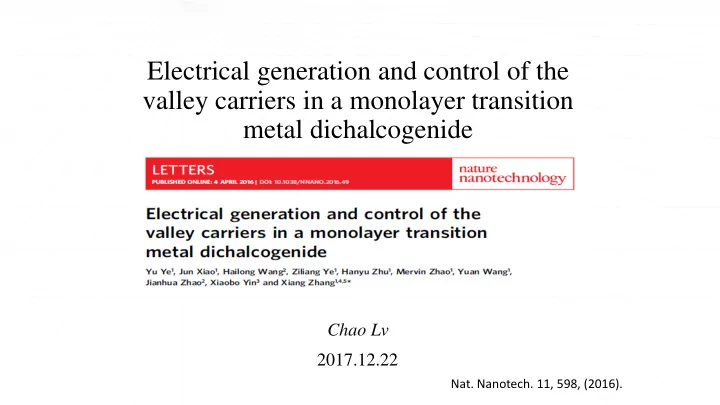

Electrical generation and control of the valley carriers in a monolayer transition metal dichalcogenide Chao Lv 2017.12.22 Nat. Nanotech. 11, 598, (2016).
Electrical valley generation Spin-orbit-coupling in 2D TMDC: 1. The strong spin – orbit interaction originating from the transition metal ion’s d orbitals introduces a large split in the valence bands. The transitions between split valence and conduction band edges are excitonic in nature, termed the A and B excitons. 2. Valley contrasting optical selection rules are therefore expected due to the spin – valley locking in TMDC monolayers. Fig.1 Electronic structure at the K and K’ valleys of monolayer TMDC Nat. Nanotech. 11, 598, (2016).
Detection in monolayer TMDCs Fig.2 Schematic of the monolayer TMDC/(Ga,Mn)As heterojunction for electrical valley polarization devices. TMDC: long lifetime of polarized hole and spin-valley locking. Ferromagnetic semiconductor : conductivity matching and high spin injection efficiency. Nat. Nanotech. 11, 598, (2016).
WS 2 /(Ga, Mn)As heterostructure Fig.3 Electroluminescence of the monolayer WS2/(Ga,Mn)As 1.97 eV heterojunctions. (A exciton) No defect emission. Suppression of B exciton emission. Nat. Nanotech. 11, 598, (2016).
Electrical Valley excitation in WS 2 Inward B Outward B Fig.4 Electrical control of valley polarization in monolayer WS 2 . ρ = 16.2% ρ = -14.8% Nat. Nanotech. 11, 598, (2016).
Magnetic field dependent Fig.5 Out-of-plane magnetic field dependence of electroluminescence helicity. Nat. Nanotech. 11, 598, (2016).
Valley exciton generation efficiency Fig.6 Valley dynamics measurement in monolayer WS 2 on (Ga,Mn)As. a, Time-resolved total photoluminescence using a σ+ polarization femtosecond excitation laser pulse with an energy of 2.21 eV. Convolution fitting with the laser pulse (green dashed line), yields two exciton lifetimes of 2.9 ps and 20.0 ps. b, Time-resolved σ+ and σ− photoluminescence components excited by a σ+ polarized laser.. Non-perfect spin polarization. Valley scattering. Nat. Nanotech. 11, 598, (2016). Joule heating.
Thanks for your attention
Recommend
More recommend